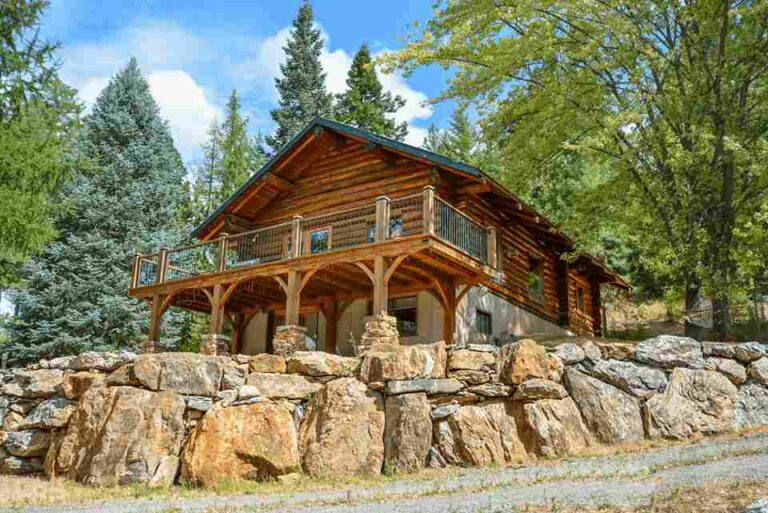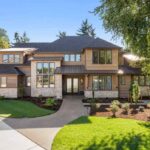So you’re thinking about buying a mountain property? Smart move.
There’s nothing like waking up to those stunning views and fresh air.
But let me tell you something right off the bat – buying in the mountains isn’t like buying in the city or suburbs. Not even close.
I’ve helped hundreds of folks buy mountain homes over the years, and I’ve seen plenty of city slickers make costly mistakes because they didn’t know what questions to ask.
Mountains have their own rules, and Mother Nature doesn’t care about your mortgage payment.
Let me walk you through the ten things you absolutely must know before you sign any papers.
Trust me, this stuff isn’t theoretical – it’s practical advice that could save you thousands of dollars and countless headaches.
How To Buy A Property In A Mountain Region
Mountain living can be amazing, but it comes with challenges most people never think about until it’s too late.
The views might be gorgeous, but what happens when a snowstorm cuts off your access road for three days? Or when you realize your cell phone has zero bars? These aren’t deal-breakers, but you need to go in with your eyes wide open.
Accessibility and Road Conditions
Let’s talk about roads first.
This is huge, folks. That winding gravel road might look charming during your summer viewing, but what about in January?
Many mountain roads aren’t maintained by counties or towns – they’re private.
That means YOU and your neighbors are responsible for maintenance, plowing, and repairs.
I’ve seen people spend $2,000+ yearly just on road maintenance costs they never budgeted for.
Who owns the road? Who maintains it? Is it paved or gravel? What’s the grade or steepness? Will you need four-wheel drive in winter? Can emergency vehicles access your property year-round?
Remember, that steep driveway might be impossible in snow and ice.
Try to visit the property after a rain to see how the roads hold up when wet.
Climate and Weather Patterns
Mountains make their own weather – that’s not just a saying, it’s science.
Your property could get totally different conditions than a spot just a mile down the road.
Temperature drops about 3-5 degrees for every thousand feet of elevation.
So while folks in the valley are enjoying 75-degree days, you might be grabbing a jacket at 62 degrees.
Snow sticks around longer at higher elevations too.
That beautiful sunny south-facing slope will have less snow than a north-facing one.
And the wind area? Mountains can create wind tunnels that’ll knock your socks off – literally.
Talk to locals about typical weather patterns.
What’s the snowfall like? How many days of sun versus clouds? When do the seasons really change? If possible, visit in different seasons before buying.
What feels like paradise in July might feel isolated and harsh in February.
Land Stability and Natural Hazards
Mountains move. Not quickly, but they do move.
Landslides, erosion, and falling rocks are real concerns in many mountain areas.
Look at the slope of the land.
Anything steeper than a 30% grade can be risky for building.
Check for signs of previous landslides – curved trees, cracks in the ground, or bare spots on otherwise vegetated slopes.
If you’re interested in areas like Tennessee, you’ll find several listings for Smoky Mountain cabins for sale, ranging from cozy, retreats to luxury homes.
But even in popular areas like this, you still need to check for hazards.
Water is both friend and enemy in mountain regions.
That bubbling creek could flood during spring melt.
That perfect view could be threatened by wildfire risks.
Always get a geological survey before buying.
It’s money well spent. And check flood maps and fire risk assessments too.
Water Supply and Quality
Where’s your water coming from? This question trips up so many first-time mountain property buyers.
City folks take water for granted.
Turn the tap, water comes out. In the mountains, it’s rarely that simple.
You’ll typically have a well, a spring, or maybe a community water system.
Wells can cost $15,000-30,000 to drill in rocky mountain terrain, and there’s no guarantee you’ll hit water. Springs can dry up during droughts.
Community systems might have restrictions or high fees.
Always test water quality before buying.
Mountain water can contain minerals, radon, or other substances that need treatment.
And make sure you understand water rights – this is a big deal in western states especially.
Ask about the water flow reliability during drought years.
Nothing ruins your mountain dream faster than having no water.
Utilities and Connectivity
Let’s talk about power and the internet.
These basics can be complicated in mountain areas.
Many remote properties don’t have access to natural gas.
You’ll use propane, which means having a tank on your property that needs regular refilling.
Electricity might come with frequent outages during storms.
Internet and cell service? Often spotty or non-existent in mountain valleys.
Satellite internet is an option, but it’s slower and weather-sensitive.
Some areas have no cell coverage at all – great for disconnecting, terrible for emergencies.
Check what utilities actually reach the property line.
Running power lines up a mountain can cost tens of thousands of dollars if it’s not already there. Same goes for internet cables.
Always bring your cell phone when viewing properties and check reception in different spots.
Try the internet speed if possible.
And ask neighbors about power outages – how frequent and how long?
Property Maintenance and Costs
Mountain properties demand more maintenance than their flatland counterparts. Fact.
Harsh weather, UV exposure at altitude, and temperature swings age buildings faster.
Wood needs more frequent staining and sealing.
Roofs take a beating from snow loads, ice, and intense sun.
Wildlife creates challenges too.
From bears checking out your trash to smaller critters trying to move into your warm attic, you’ll need to animal-proof your place.
Budget about 1.5 to 2 times what you’d spend on maintenance for a similar-sized house in the city.
And find reliable service providers before you need them – good luck finding a plumber to drive up your mountain road during a snowstorm if you haven’t established a relationship.
Also, think about the physical demands.
Shoveling snow at 8,000 feet elevation feels very different than at sea level.
Can you handle the physical aspects of mountain property renovation?
Local Zoning and Building Regulations
Mountain communities often have strict rules about what you can build and how.
For good reason – these regulations protect the environment and your home investment.
Some areas have view ordinances that limit building heights.
Others have strict rules about clearing trees.
Many have special requirements for septic systems because of the rocky soil.
Always check the zoning of not just your property but surrounding areas too.
You don’t want to build your dream home only to have someone put up a commercial building next door.
Building costs are typically 20-40% higher in mountain areas due to difficulties with access, materials transport, and specialized foundation requirements.
And permits can take longer to get approved.
Before buying, check with the local building department about any restrictions.
If you’re planning to build, talk to local contractors about realistic costs and timelines.
Mountain construction almost always takes longer than expected.
Proximity to Amenities and Healthcare
That secluded mountain paradise comes with tradeoffs.
How far are you willing to drive for groceries? For a hospital?
Many mountain residents plan shopping trips carefully, stocking up on supplies to avoid frequent long drives.
Think about how far you’re comfortable being from basic services like grocery stores, hardware stores, and gas stations.
Healthcare access is critical.
Some mountain areas are an hour or more from the nearest hospital.
Response times for ambulances can be much longer than in cities.
If you have health conditions requiring regular care, this matters.
Schools too – if you have kids, how long will their bus ride be? Is the road even accessible for school buses? Some mountain families end up driving their kids long distances daily.
Make a list of services you need regular access to, then map their distances from your potential property.
Be honest with yourself about what isolation level works for your lifestyle.
Lifestyle and Seasonal Use
Ask yourself: Is this a vacation home or your forever home? The answer changes everything.
Vacation homes sit empty most of the time, creating unique challenges.
You’ll need someone to check on the property, keep pipes from freezing, and make sure critters haven’t moved in.
Year-round living means experiencing all seasons – including the ones tourists avoid.
Those quiet winter months can be magical or isolating, depending on your personality.
Consider your hobbies and needs.
If you love gardening, check the growing season at that elevation.
If you need social interaction, how far are the nearest restaurants and community events?
Talk to both year-round residents and vacation homeowners about their experiences.
Their insights will be golden.
Long-Term Investment Value
Mountains have limited buildable land – that’s good for property values over time.
But not all mountain properties appreciate equally.
Properties with these features typically hold value better: year-round access, stunning but protected views, proximity to popular attractions or towns, and reliable utilities.
Climate change is affecting mountain regions, sometimes dramatically.
Areas prone to wildfires or with diminishing snowfall might see values impacted.
Research historical price trends in the specific area you’re considering.
Some mountain towns have seen explosive growth while others have stagnated.
Local economies matter – is the area dependent on a single industry like tourism or mining?
Remember that unique properties can be harder to sell.
That quirky off-grid cabin might be your dream, but will others feel the same way when you’re ready to sell?
Conclusion
Buying mountain property can be one of the best decisions you’ll ever make.
The beauty, privacy, and connection to nature are unmatched.
But go in smart. Ask tough questions. Visit in multiple seasons if possible.
Every mountain property has tradeoffs.
The place with the best view might have the worst road.
The most affordable lot might have water challenges. Know what matters most to you, and what you can compromise on.
And please, work with professionals who know mountains.
Find a real estate agent who specializes in mountain properties.
Get proper inspections from people who understand mountain construction challenges.
Mountains have called to humans forever.
They represent freedom, beauty, and escape.
Just make sure your escape doesn’t turn into a trap by skipping the homework on these ten critical areas.
When done right, mountain property ownership is absolutely incredible.
Nothing beats that morning coffee with a valley view.



